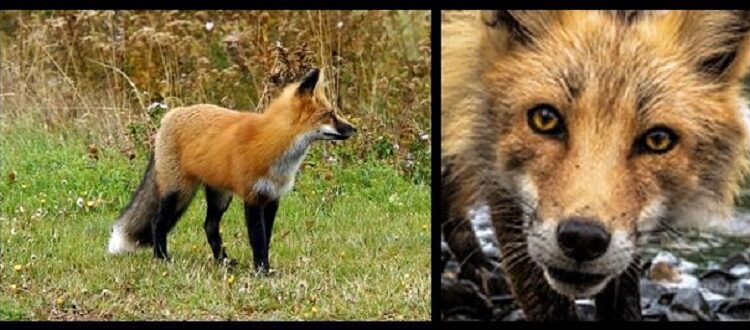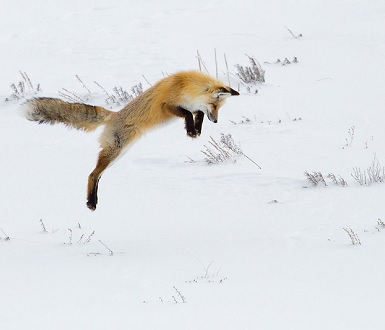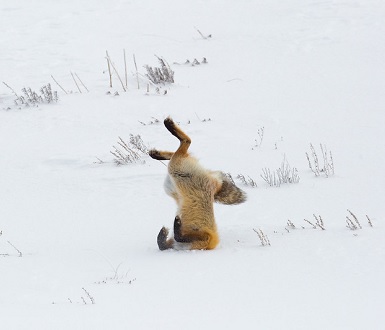CREATURE FEATURE – The Suburban Fox
North American red fox (Vulpes vulpes fulva) – images (1) by Dennis Jarvis CC-BY-SA-2.0 & (2) pub domain
GET TO KNOW – North American
Red Fox
In folklore and common literature, foxes are most often portrayed as sly and cunning. The fox is the trickster who outmaneuvers both farmer and hunter – though the fox, itself, is sometimes tricked by a wise little rabbit.
FUN FACT: Some researchers believe that the red fox, much like ancient ancestors of modern dogs, is in the process of domesticating itself. Due to habitat loss, the ever resilient red fox has moved into suburbia where it happily lives, breeds, and even thrives. Researchers are noticing subtle biological changes in these suburban red foxes. Some believe that the normally nocturnal fox is evolving to be more active in the daytime. Other researchers see small changes developing in the structure of red fox skulls that may be following early adaptations in dog evolution. (Note: red foxes are still very much wild animals and should not be approached.)
The origin of such perceptions most likely lies in the fox’s natural hunting methods. Unlike their dog and wolf cousins, foxes are not pack animals. They do not travel, prowl, or hunt together in (possibly noisy) groups. Rather, they hunt individually while moving silently and stealthily through the night.
While there are a number of different types of foxes, the red fox (Vulpes vulpes) is the most widely distributed and the most well-known. Red foxes not only live up to their wily reputation, they are also highly adaptable. These beautiful creatures successfully inhabit ecosystems ranging from forests and grasslands to mountains and deserts. And, increasingly, red foxes are joining us in our parks and gardens while making themselves at home in suburbia.
Around the world there are some forty-five subspecies of red fox. The North American red fox (Vulpes vulpes fulva), is relatively small (averages less than 20 lbs) and is best identified for its bright, reddish-orange coat, black ears, black legs and bushy, white-tipped tail. The fox pictured above proudly displays a very intense version of this color pattern. However, there are a number of color morphs within the red fox (Vulpes vulpes) species that include black, gray, sliver, amber and mixed-color coats. Consequently, a great many red foxes aren’t red at all, and some may be mistaken for grey foxes. (Of course – just to be confusing – grey foxes aren’t always grey either.)
HABITAT AND LIFE CYCLE
In the wild, red foxes tend to rest during the day and hunt during the evening, night, or early morning. They are active year round and appear to manage very well in even the coldest of winters. Known to be curious and playful, red foxes display a rather odd combination of “independent and solitary” traits as well as “highly social, family oriented” traits.
On the one hand, red foxes typically prowl, hunt, rest and sleep alone. Yet, they construct elaborate dens that may be used and expanded upon by successive generations over decades.
A red fox den is constructed and maintained by mated females. The den, which is often referred to as a “natal den,” may slope down as deep as eight feet, and the various tunnels may stretch out some fifty feet to connect multiple entrances/exits and numerous specialized chambers for birthing, caring for young, and storing food. Adult males rarely venture very far into the den, but they regularly deliver food for their kits and occasionally rest just within an entryway. Yet, outside of the annual cycle of breeding and caring for young kits, both adult males and females maintain independent and solitary existences.
Breeding pairs of red foxes are believed to bond for life. Wintertime mating calls are loud, piercing shrieks from the females, and some male red foxes will select more than one female as a bonded partner. In such cases, “sister” female partners may equally share the same natal den and food provisions brought by the male.
Fox kits are born blind and helpless, and the mother stays within the den to guard and provide parental care. Both the male fox – and sometimes older female siblings – deliver food to the den until such time as the mother starts teaching the new kits to hunt.
The most preferred menu items for a red fox family are a variety of small rodents. But red foxes are never choosy and will eat small birds, eggs, reptiles and amphibians, and even fish. They are also true omnivores that happily consume just about any edible thing they can scavenge including fruits, many crops, garbage and carrion. Excess rations of food are routinely gathered and stored both in the natal den and in specially excavated (and scent marked) temporary “cellars.”
In addition to being highly adaptable, red foxes are blessed with exceptional athleticism and very keen senses. They run along at over 30 mph, jump up to six feet in the air, swim, and in some circumstances go up trees. Technically, red foxes cannot actually climb trees (although grey foxes can), but they do have semi-retractable front claws and strong back legs. These features, combined with their ability to jump, allow them to venture up certain trees. (This depends on trunk angle and branch placement.)
Though biologically canines, red foxes hunt more like cats. As mentioned, they generally hunt alone and at night. They also have eyes that function like cat eyes and provide exceptional night vision, and they rely on extremely acute hearing to locate prey – even when it is scurrying along under cover of deep leaves or snow. Once prey is located, the red fox does not chase it down and shake it. Rather the red fox generally waits for opportunity, then leaps into the air and dives onto its prey with a single pounce. Even in winter, the red fox happily dives head first into deep snow as it pounces, and pictures of such snow dives are highly comical. But, hey, it works for the fox!
Unfortunately, even though- as a species – red foxes are accomplished survivalists, individual red foxes survive only an average of two to three years in the wild. Young foxes are preyed upon by eagles, coyotes, wolves and bears. Likewise, as with many wild creatures, humans pose the greatest threat to these foxes through hunting, “pest elimination,” and traffic encounters.
TAKE ACTION
Red foxes may be found in every Michigan county including around our urbanized Rouge River watershed. FOTR is working hard to preserve natural riparian corridors along the river and to protect valuable habitat for these beautiful creatures. This spring, summer and fall, Friends of the Rouge will sponsor a wide variety of restoration activities including planting more than more than 14,000 tree saplings along the lower Rouge River floodplain.
Check our website here to find upcoming volunteer activities and sign-up to help protect and restore our watershed.





